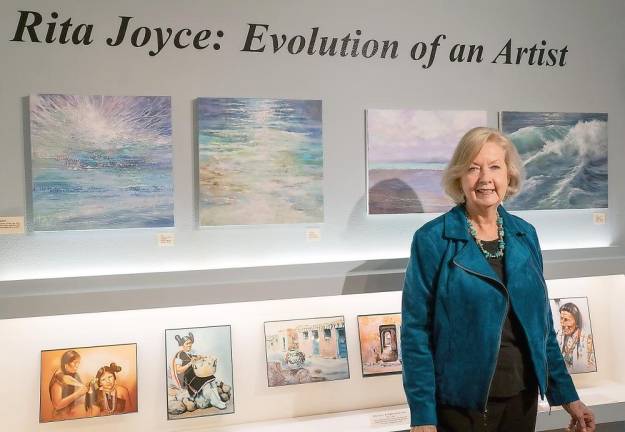A passion for art outweighed her father’s advice
Sparta. Rita Joyce, whose one-woman show is the summer exhibit at the Van Kirk Homestead, was labeled a “unique” artist because she keeps reinventing her styles and subjects.

As a schoolgirl, Rita Joyce of Sparta is quick to admit that her grades for art class were much better than for her other subjects. But raw talent was only the beginning.
“From the very beginning art was my burning passion and career,” Joyce said, “but my engineer father told me straight out that I couldn’t make a living at art.”
Having no parental support, she started working after school to pay for art classes and supplies.
She grew up on a small farm with a seven-acre walnut orchard adjacent to Roy Roger’s ranch in Encino, California. She went to school with the children of actors who’d moved 15 miles from Hollywood to “the country,” and she would see John Wayne and Dick Van Dyke in the grocery store.
She sold her first piece of art to a soap opera actress and was able to sell more paintings through art club and sidewalk shows. Joyce’s first gallery show of her paintings was in her early twenties.
Oils were Joyce’s first medium, having taken a class from a Dutch master as a teenager. But she realized she would need to adapt to whatever would sell. She paid attention to trends and then modified her style by finding artists she admired and paying them dearly by the hour to teach her. To support herself and her family, she gave lectures and demonstrations before art clubs, taught painting for 30 years, and sold her art in more than 45 galleries and on cruise ships.
When “primitives” were a trend, she and her woodworking husband started making small wooden boxes and then moved into furniture, with Tom building and Rita designing, finishing, and decorating the pieces they sold in Malibu, Hollywood, and other affluent towns. Joyce’s paintings and their furniture were part of the Carnegie Art Museum’s “Masters in Our Midst” annual competitive exhibition.
Although galleries prefer artists who can be neatly categorized, Joyce was labeled a “unique” artist because she kept reinventing her styles and subjects. She spent an unheard-of 15 years with one gallery in Hollywood, earning its loyalty by promising always to provide what they could sell. She would check in every month to see what she needed to do, then she would paint and deliver. As the work was always on consignment, this served Joyce’s financial goals.
Her artistic goals kept changing. She moved between oils, watercolors, and pastels, then began “mixing medias to challenge my comfort zone,” she said. She feeds her soul by pursuing a variety of subjects for her paintings. On a recent day in her studio, a vibrant parrot tulip was glowing from her large canvas in minute detail, in impressive contrast to the other paintings and sketches in the room that included exotic animals, landscapes, Amazon tribal portraits, and abstracts, some incorporating gold leaf, diamond dust, and other materials. Joyce was involved with exotic animals as a volunteer at Shambala, the animal sanctuary started and run by Tippi Hedren, the star of Alfred Hitchcock’s 1963 movie “The Birds.”
Recently Joyce completed two series of paintings on the blown-glass floats from Japanese fishing nets – as you’ll see in the Sparta Historical Society’s summer exhibit. The floats are a metaphor for her life, and that may ring true for many visitors. The exhibit showcases Joyce’s life journey as seen through her art, in early works up to the present, showing her ability to re-invent herself and her art to keep up with the constant changes over her 60-year career.
The Sparta Historical Society’s summer arts exhibition, “Rita Joyce: Evolution of an Artist,” opened this month at The Van Kirk Homestead Museum. Click here for more information about this exhibit and other summer happenings at the museum.
“From the very beginning art was my burning passion and career, but my engineer father told me straight out that I couldn’t make a living at art.” Rita Joyce